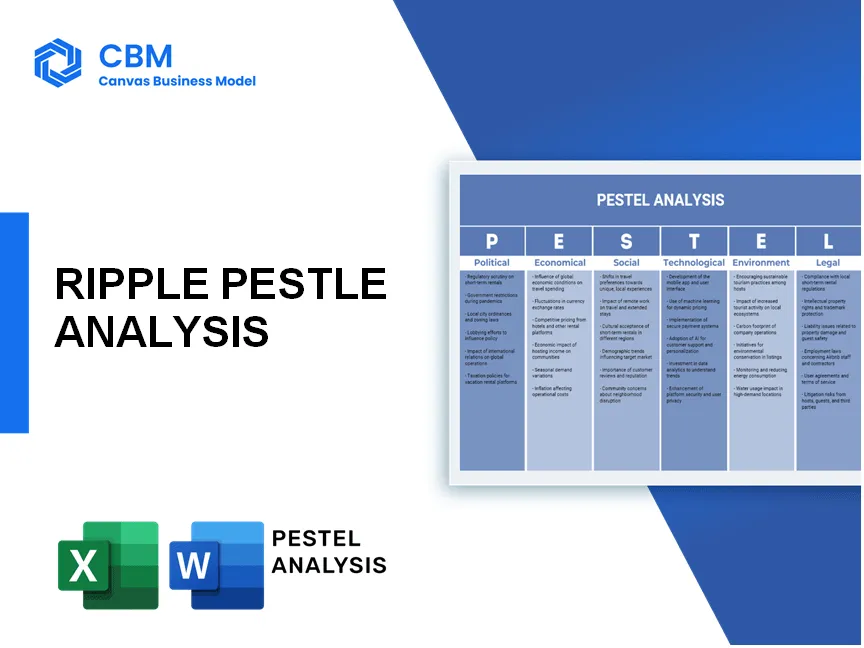In the rapidly evolving landscape of digital finance, Ripple stands at the forefront of innovation, driving change in cross-border payments and cryptocurrency solutions. This PESTLE analysis delves into the multifaceted influences shaping Ripple's operations, from political scrutiny and economic dynamics to technological advancements and environmental considerations. Discover how these pivotal factors interplay and propel Ripple's quest to redefine the future of finance beneath the surface.
PESTLE Analysis: Political factors
Regulatory scrutiny of cryptocurrency markets
The cryptocurrency market has faced increasing regulatory scrutiny globally. As of 2022, approximately 60% of the world's governments were considering or have implemented regulations surrounding cryptocurrencies. Notably, the U.S. SEC filed a lawsuit against Ripple Labs in December 2020 over the sale of XRP, alleging it to be an unregistered security. The outcome of such regulatory actions can significantly impact Ripple's operations and market access.
Government policies promoting digital currency adoption
Government policies in various regions are increasingly favoring digital currency adoption. For instance, in 2021, El Salvador became the first country to officially adopt Bitcoin as legal tender, which led to a 30% increase in transaction volumes for digital currencies in Latin America. In 2023, it was reported that over 75% of central banks worldwide are exploring Central Bank Digital Currency (CBDC) initiatives.
International trade agreements impacting cross-border payments
International trade agreements critically affect cross-border payment systems. For example, the Comprehensive and Progressive Agreement for Trans-Pacific Partnership (CPTPP), which involves 11 countries, aims to facilitate trade by promoting electronic commerce and reducing barriers to cross-border data flow. As of 2023, cross-border payments in the Asia-Pacific region are projected to reach $240 billion by 2025, illustrating the potential benefits of these agreements.
Central banks exploring digital currency initiatives
Central banks are actively investigating digital currency initiatives, with over 87% of global central banks conducting research related to CBDCs as of 2023. Notably, the People's Bank of China has initiated pilot programs for the digital yuan, with over $5 billion worth of transactions recorded as of mid-2023, indicating substantial interest and potential for market expansion.
Political stability influencing investment in fintech
Political stability plays a significant role in influencing investment decisions within the fintech sector. In countries with stable political climates, such as the U.S. and Switzerland, fintech investments reached approximately $69 billion in 2021. Conversely, regions experiencing political turmoil, such as Venezuela, have seen a decline in fintech investment by over 50% from previous years.
| Political Factor | Data / Statistics | Impact |
|---|---|---|
| Regulatory scrutiny of cryptocurrency markets | ~60% governments considering cryptocurrency regulations | Legal challenges and market access issues for Ripple |
| Digital currency adoption | El Salvador adopted Bitcoin as legal tender | Increased transaction volumes in Latin America |
| International trade agreements | Cross-border payments in Asia-Pacific projected at $240 billion by 2025 | Facilitates Ripple's market expansion |
| Central bank CBDC initiatives | 87% of global central banks researching CBDCs | Opportunities for partnerships |
| Political stability | Fintech investments in stable countries at $69 billion in 2021 | Attracts foreign direct investment |
[cbm_pestel_top]
PESTLE Analysis: Economic factors
Growing demand for efficient cross-border payment solutions
The global remittance market reached approximately $702 billion in 2020, with an expected annual growth rate of 5.3% from 2021 to 2027. In 2021, cross-border payment transactions were valued at over $156 trillion. Ripple aims to capture this growing demand through its innovative liquidity and payment solutions.
Fluctuations in cryptocurrency values affecting liquidity
In 2021, the price of Bitcoin reached a high of about $64,000, while Ethereum peaked at around $4,800. However, in June 2022, Bitcoin fell to approximately $18,000, leading to increased volatility within the cryptocurrency market. Such fluctuations can directly impact liquidity for Ripple's technology, influencing transaction volumes and market stability.
Economic downturns impacting financial transaction volumes
The global economic downturn caused by the COVID-19 pandemic saw GDP contractions in major economies. In 2020, the U.S. GDP contracted by 3.4%, while the Eurozone's GDP decreased by 6.6%. Economic instability often leads to decreased financial transactions, which can affect companies like Ripple that rely heavily on transaction volumes.
Rise of remittances contributing to market growth
The World Bank reported that global remittances increased by 8% to $540 billion in 2020, and this trend is expected to rise further. The growing number of migrant workers, estimated at over 272 million globally, contributes significantly to this increase, presenting opportunities for Ripple's cross-border payment solutions.
Central bank digital currencies reshaping payment ecosystems
As of October 2023, over 90 countries are exploring or developing Central Bank Digital Currencies (CBDCs). China's digital yuan is in the advanced pilot phase, with over 400 million users and around $20 billion in transactions processed since its launch. The effects of CBDCs on traditional banking and payment systems are expected to be profound, driving further innovations in companies like Ripple.
| Factor | Data Point | Source |
|---|---|---|
| Global Remittance Market Value (2020) | $702 billion | World Bank |
| Cross-Border Payment Transactions Value (2021) | $156 trillion | Various Financial Reports |
| U.S. GDP Contraction (2020) | 3.4% | Bureau of Economic Analysis |
| Eurozone GDP Decrease (2020) | 6.6% | Eurostat |
| Global Remittances Increase (2020) | 8% | World Bank |
| Estimated Global Migrant Workers | 272 million | UN International Organization for Migration |
| CBCD Development in Countries (October 2023) | 90 | Bank for International Settlements |
| Digital Yuan Transactions (October 2023) | $20 billion | People's Bank of China |
PESTLE Analysis: Social factors
Sociological
Increasing public interest in cryptocurrency for transactions
The global cryptocurrency market capitalization reached approximately $2.19 trillion as of October 2021, indicating a growing interest. Surveys show that around 46% of Americans are familiar with cryptocurrencies, and 14% have used them in transactions.
Change in consumer preferences towards digital solutions
According to a report by Statista, the digital payment transaction value is projected to reach $10.52 trillion worldwide by 2025. Furthermore, a survey found that 73% of consumers prefer to transact online rather than in-person.
Growing acceptance of mobile payments among consumers
In 2021, mobile payment users reached approximately 1.3 billion globally, with expected growth to 1.9 billion by 2024. Additionally, a survey by McKinsey indicated that 50% of respondents felt comfortable using mobile wallets for payments, with a notable increase in contactless transactions.
Demographics shifting towards tech-savvy younger populations
Data from Pew Research Center indicates that 83% of adults aged 18-29 use smartphones, a demographic more inclined towards adopting cryptocurrency solutions. Moreover, market analysis from Deloitte suggests millennials and Gen Z are significantly more engaged in the cryptocurrency space, with around 30% of those aged 18-34 owning digital currencies.
Trust issues in traditional banking fueling crypto adoption
A survey conducted by Gallup in 2020 revealed that only 30% of Americans have a high degree of trust in banks. Coupled with increasing incidents of bank fees, 40% of consumers expressed interest in using a decentralized currency alternative, such as cryptocurrencies, as a response to traditional financial institutions.
| Statistical Data | Figures |
|---|---|
| Global Cryptocurrency Market Capitalization | $2.19 trillion |
| Percentage of Americans Familiar with Cryptocurrencies | 46% |
| Projected Digital Payment Transaction Value by 2025 | $10.52 trillion |
| Mobile Payment Users in 2021 | 1.3 billion |
| Mobile Payment Users Expected by 2024 | 1.9 billion |
| Percentage of Adults Aged 18-29 Using Smartphones | 83% |
| Millennials and Gen Z Engaged in Cryptocurrencies | 30% |
| Americans with Trust in Banks | 30% |
| Consumers Interested in Decentralized Currency Alternatives | 40% |
PESTLE Analysis: Technological factors
Advancements in blockchain technology enhancing payment security
The evolution of blockchain technology continues to reshape the landscape of payment security. According to a report from Statista, the blockchain technology market is estimated to reach $67.4 billion by 2026, growing at a CAGR of 67.3% from 2022. Ripple's implementation of blockchain ensures that transaction confirmations occur in mere seconds, compared to traditional banking systems which can take days.
Integration of AI and machine learning in payment processing
The utilization of Artificial Intelligence (AI) and machine learning within payment processing is a growing trend. A 2022 report by Juniper Research projected that AI-powered payment fraud detection solutions could save the banking sector approximately $71 billion by 2025. Companies like Ripple leverage AI to enhance transaction security and optimize user experience.
Development of APIs improving access to financial ecosystems
The rise of Application Programming Interfaces (APIs) is critical for enhancing access to financial services. As of 2023, the global API management market was valued at approximately $3.4 billion and is projected to grow to around $13.7 billion by 2029, according to Fortune Business Insights. Ripple's API solutions facilitate seamless integration into existing financial infrastructures, allowing faster and more secure transaction processing.
| Year | Global API Management Market Value (in billion USD) | Projected Growth Rate (CAGR) |
|---|---|---|
| 2023 | 3.4 | 25.1% |
| 2029 | 13.7 |
Emergence of new fintech startups innovating in payments
The fintech landscape is witnessing an influx of startups dedicated to innovating payment solutions. As of mid-2023, there are more than 30,000 fintech startups globally, contributing to a market valued at $312 billion in 2022, according to Statista. Ripple’s partnerships with various fintech companies allow it to stay at the forefront of payment innovations, particularly in cross-border transactions.
Continuous evolution of cybersecurity measures for digital finance
Cybersecurity has become an essential aspect of digital finance, with a rising cost attached to breaches. A 2023 report by Cybersecurity Ventures predicts that damage from cybercrime will reach $10.5 trillion annually by 2025, highlighting the urgency for advanced cybersecurity measures. Ripple's ongoing investments in encryption technologies and compliance protocols are pivotal in safeguarding transactions within its network.
PESTLE Analysis: Legal factors
Evolving regulatory frameworks for cryptocurrencies globally
Across jurisdictions, the regulatory landscape for cryptocurrencies has been transforming, with numerous governments implementing new frameworks. As of October 2023, over 60 countries have established regulations specifically concerning cryptocurrencies, with prominent examples including:
| Country | Regulatory Authority | Key Regulations | Year Implemented |
|---|---|---|---|
| United States | SEC, CFTC | SEC's guidance on digital assets | 2020 |
| European Union | European Commission | MiCA Regulation | 2024 |
| United Kingdom | FCA | Cryptoasset regulations | 2022 |
| Japan | FSA | Payment Services Act | 2017 |
| Singapore | MAS | Payment Services Act | 2020 |
This evolution significantly impacts Ripple's operational strategies and compliance measures as it navigates the complexities of these frameworks.
Compliance requirements impacting operational costs
The costs associated with compliance for cryptocurrency firms continue to rise. As of 2023, it is estimated that firms could spend upwards of $2 million annually on compliance measures. Ripple has to allocate substantial resources to meet these requirements, which include:
- Anti-Money Laundering (AML) efforts
- Know Your Customer (KYC) protocols
- Transaction monitoring systems
- Tax reporting compliance
The increasing scrutiny and complexity of compliance contribute to the overall operational costs, which are projected to rise by 25% by 2025.
Legal challenges associated with cross-border transactions
Cross-border transactions often face legal hurdles that vary from country to country. For instance, as of July 2023, regulatory bodies in over 70% of jurisdictions are still grappling with how to treat cryptocurrency transactions legally. Ripple's efforts to streamline cross-border payments are made complex by:
- Divergent national laws
- Tax implications of transactions
- Restrictions on currency conversions
Recent legal disputes include cases in the U.S. where Ripple faced scrutiny regarding the classification of XRP as a security, potentially affecting over $1.8 billion in sales.
Intellectual property protection for technology innovations
Intellectual property (IP) is critical for Ripple as it safeguards its innovations in blockchain technology. As of October 2023, Ripple holds approximately 40 patents related to blockchain solutions and payment technologies. The company invests around $5 million annually in legal measures to protect its IP against infringement and litigation.
| Year | Patents Filed | Patents Granted | Annual IP Investment |
|---|---|---|---|
| 2021 | 5 | 3 | $4 million |
| 2022 | 10 | 8 | $5 million |
| 2023 | 15 | 10 | $5 million |
Securing and expanding its IP portfolio is essential for Ripple to maintain a competitive edge in the rapidly evolving fintech landscape.
Anti-money laundering regulations influencing cryptocurrency operations
Anti-money laundering (AML) regulations are significant in shaping Ripple’s operational framework. The global AML strategy in 2023 mandates that all cryptocurrency entities adhere to stringent reporting and compliance requirements, affecting companies like Ripple:
- In the U.S., penalties for non-compliance can exceed $10 million
- EU regulations require transaction thresholds to be reported above €1,000
- 2023 estimates show that AML compliance costs could reach up to $3 million for larger firms
Ripple’s compliance readiness and active engagement in AML discussions reflect its commitment to regulatory adherence while mitigating financial risks associated with non-compliance.
PESTLE Analysis: Environmental factors
Energy consumption concerns with cryptocurrency mining
The energy consumption associated with cryptocurrency mining has reached concerning levels. According to the Cambridge Centre for Alternative Finance, Bitcoin mining alone is responsible for approximately 0.5% of the global electricity consumption, equivalent to around 74 TWh annually as of 2022. This has raised alarms about the sustainability of cryptocurrency technologies.
Ripple's commitment to sustainability initiatives in operations
Ripple has made substantial commitments to sustainability. In 2021, Ripple announced a plan to achieve carbon neutrality by 2030. In its recent sustainability report, Ripple stated that 100% of its energy consumption is sourced from renewable energy. Ripple's energy-efficient consensus protocol significantly reduces its carbon footprint compared to traditional proof-of-work blockchain systems.
Increasing regulations on carbon footprint for tech companies
With the rise of environmental concerns, regulations surrounding carbon emissions are tightening. For instance, the European Union's Green Deal aims to make Europe climate-neutral by 2050, which includes stringent regulations on carbon emissions from tech companies. Ripple, in line with such regulations, is focusing on improving its operational transparency and reducing its emissions to comply with emerging standards.
Shift towards eco-friendly technologies in digital finance
The digital finance sector is increasingly adopting eco-friendly technologies. Ripple's own XRP Ledger, for instance, processes transactions with an energy cost of approximately 0.0079 kWh per transaction. In comparison, Ethereum was estimated to consume around 70 kWh per transaction before the shift to Ethereum 2.0.
Growing awareness of environmental impact among consumers
Consumer awareness regarding the environmental impacts of products is on the rise. A 2021 survey found that 76% of consumers are concerned about the environmental effects of cryptocurrency transactions. This increased scrutiny is pushing companies, including Ripple, to enhance their sustainability initiatives.
| Factor | Current Data | Reference Year |
|---|---|---|
| Global electricity consumption by Bitcoin mining | 74 TWh | 2022 |
| Ripple's carbon neutrality target year | 2030 | 2021 |
| Energy consumption per XRP transaction | 0.0079 kWh | 2022 |
| Ethereum's estimated energy consumption per transaction pre-upgrade | 70 kWh | 2022 |
| Percentage of consumers concerned about environmental impact | 76% | 2021 |
In summary, Ripple stands at the intersection of technology and finance, navigating a complex landscape shaped by political nuances and economic shifts. As they harness cutting-edge advancements in blockchain and AI, their influence in cross-border payments and cryptocurrency liquidity continues to grow. However, the company faces challenges from evolving regulations and a heightened focus on sustainability within the tech industry. Ultimately, understanding the intricacies of these PESTLE factors is essential for grasping Ripple's potential in a rapidly changing global economy.
[cbm_pestel_bottom]











